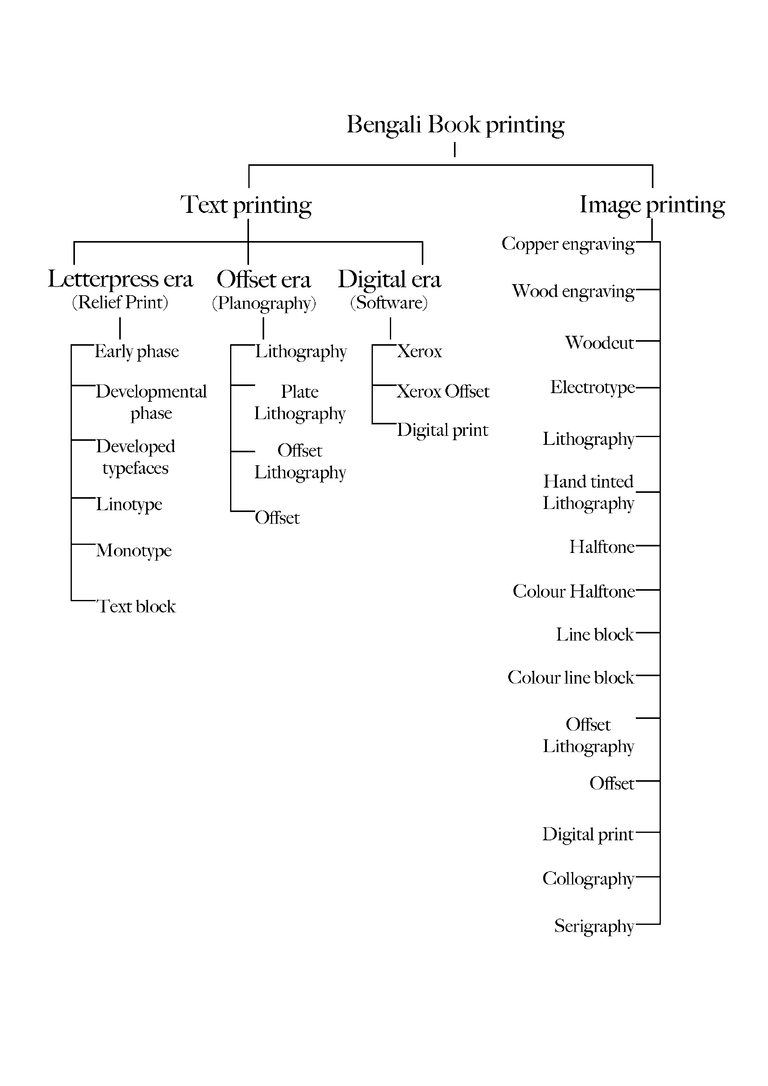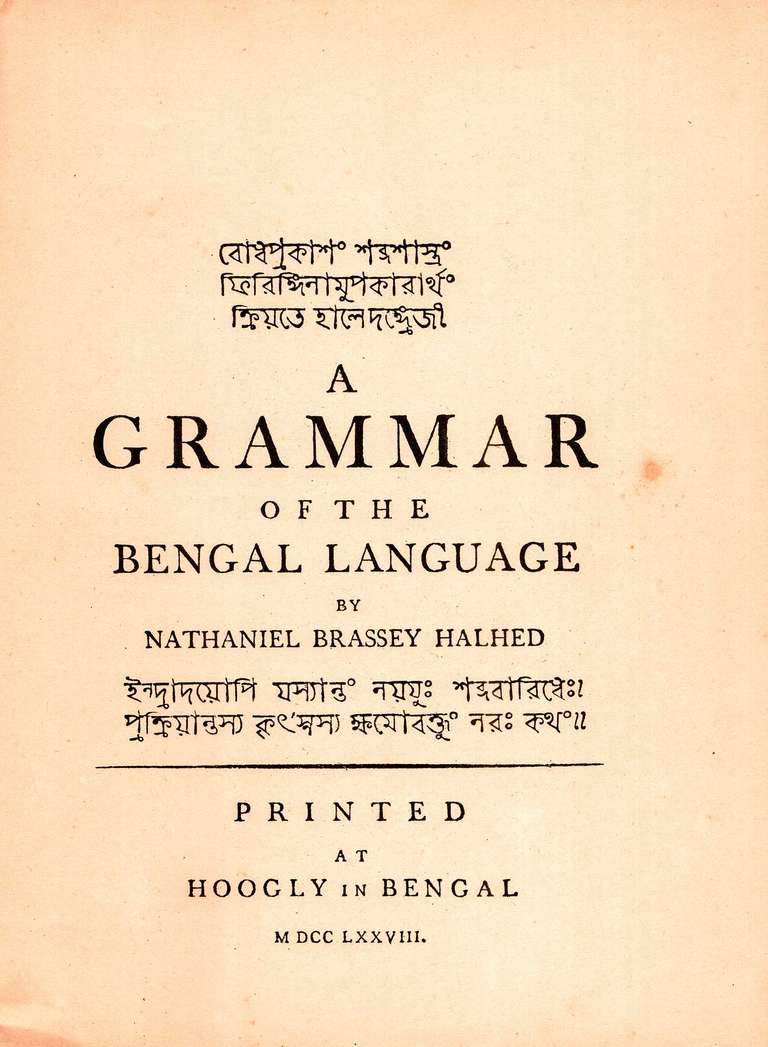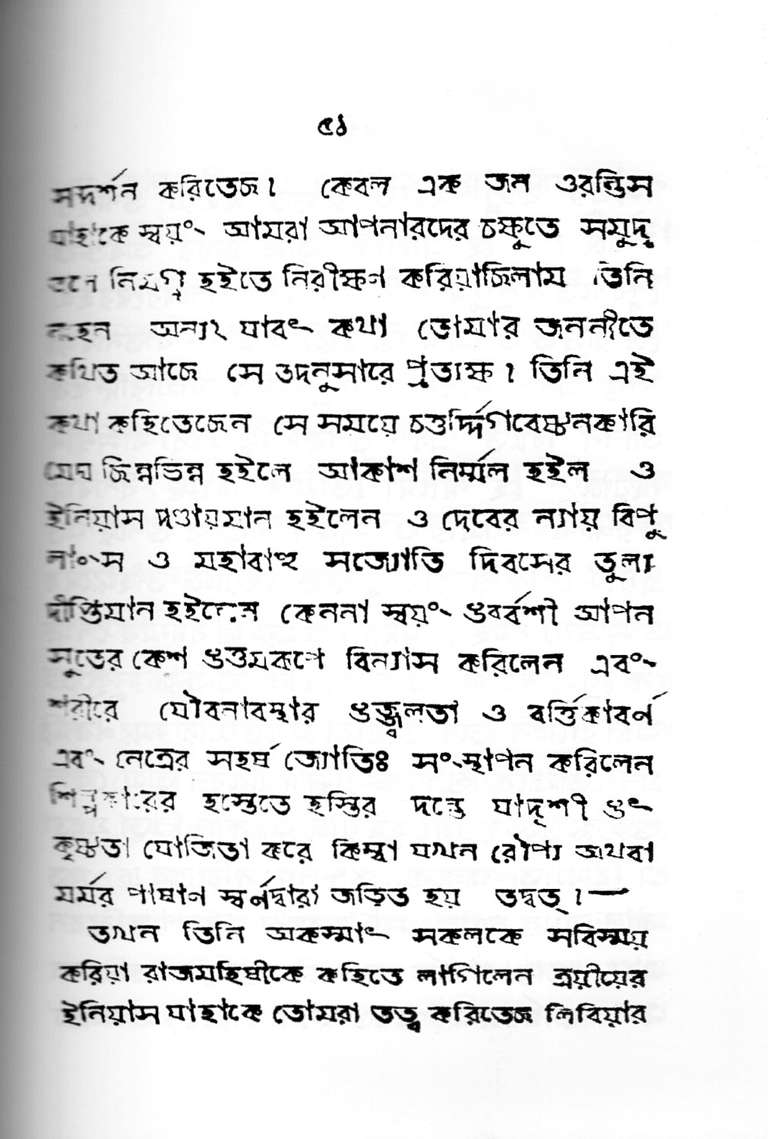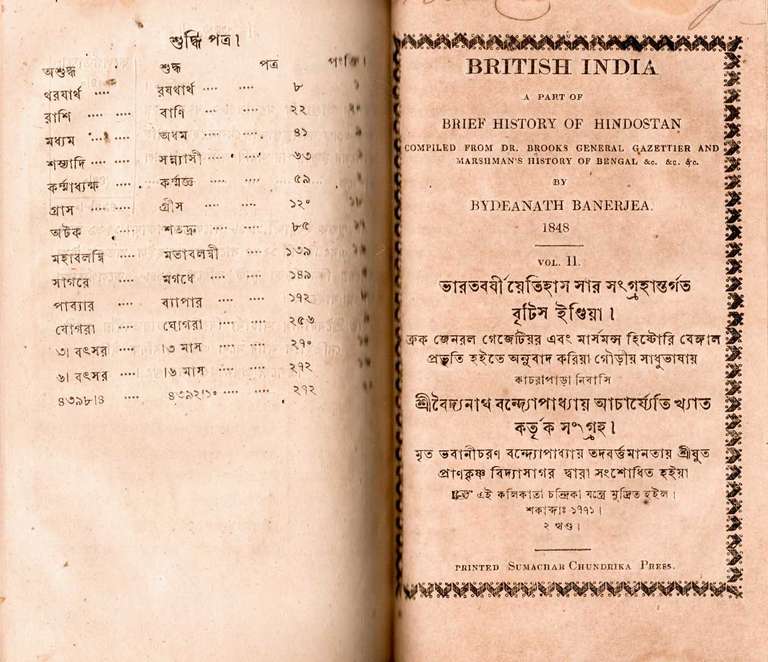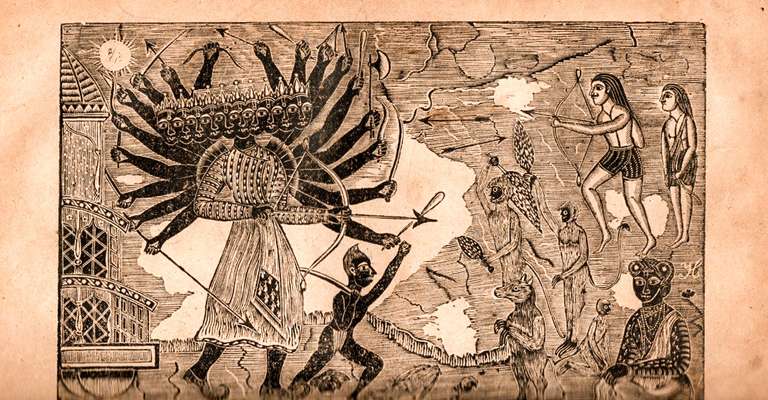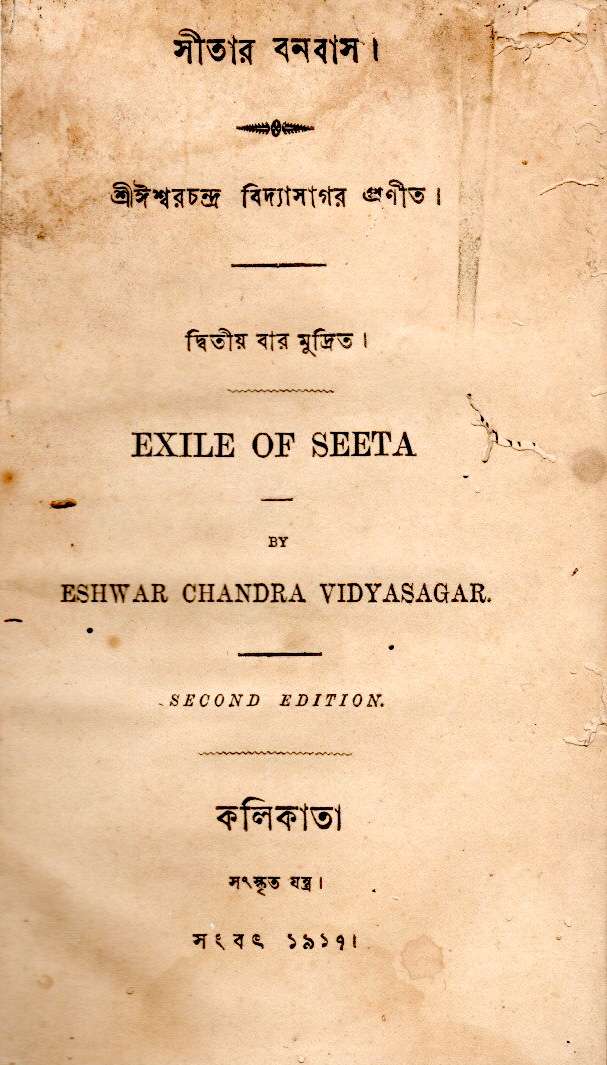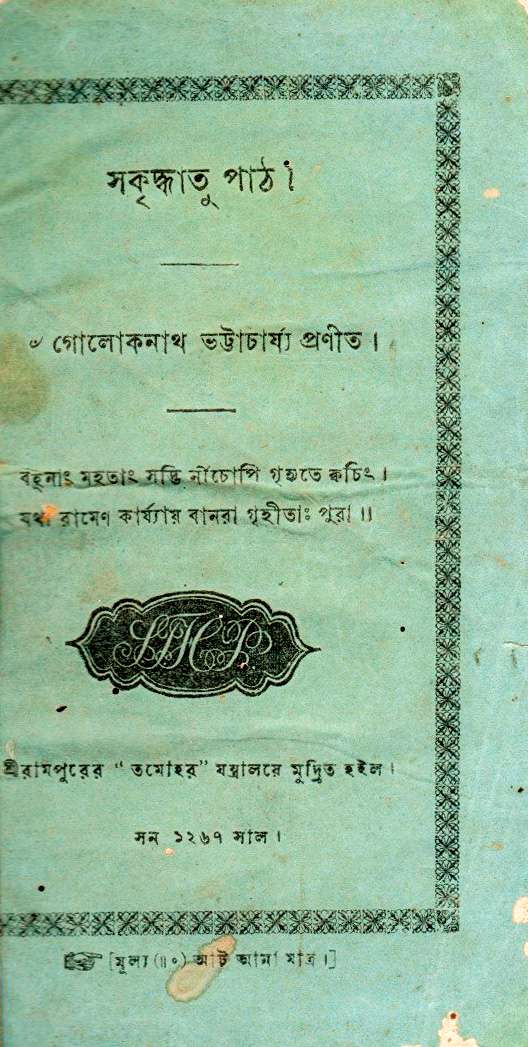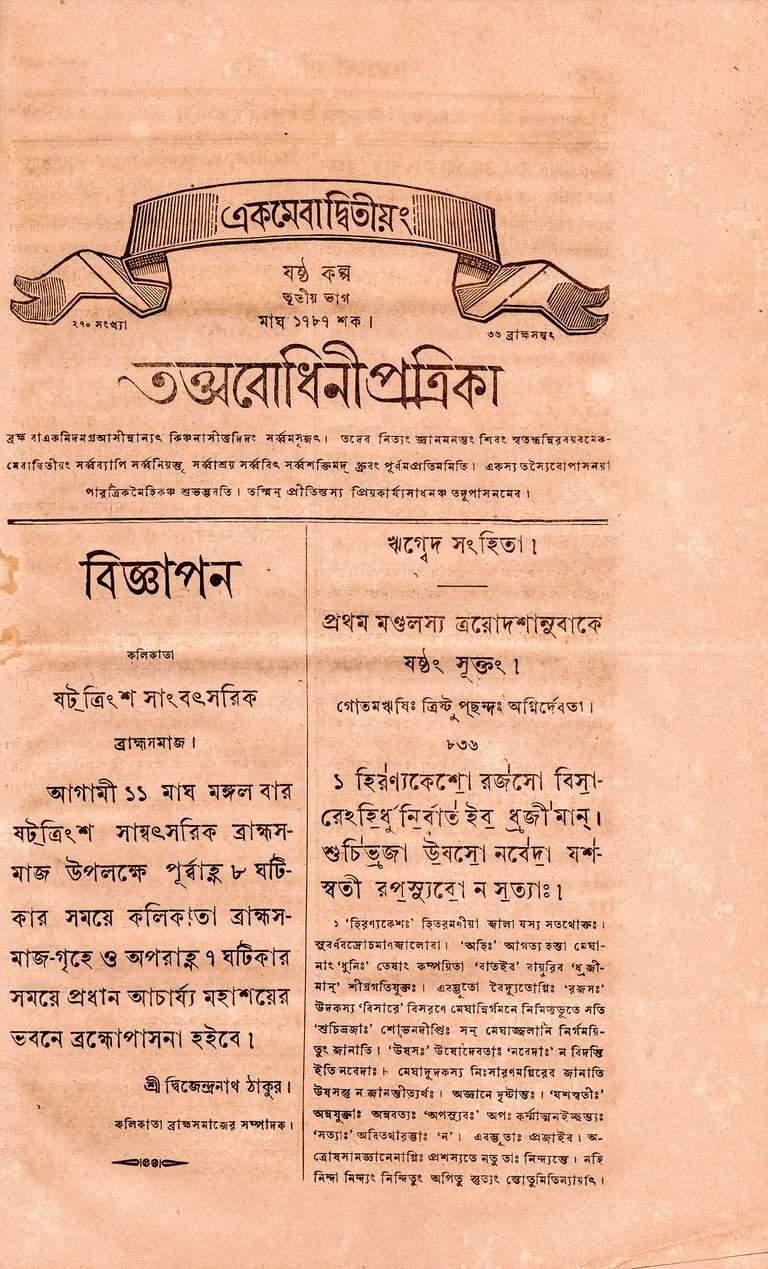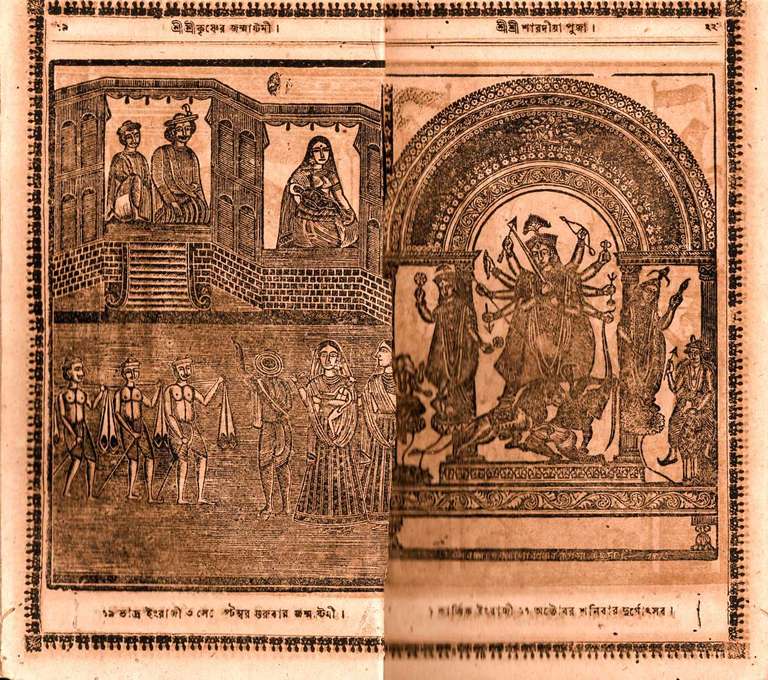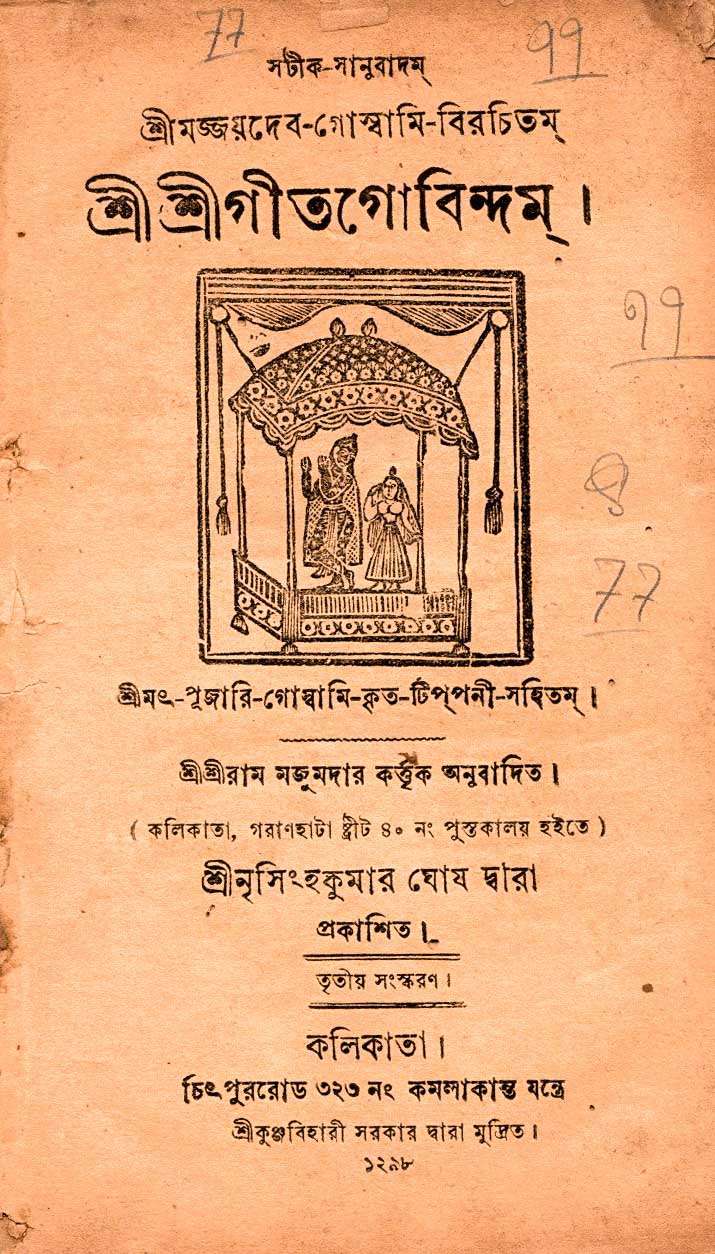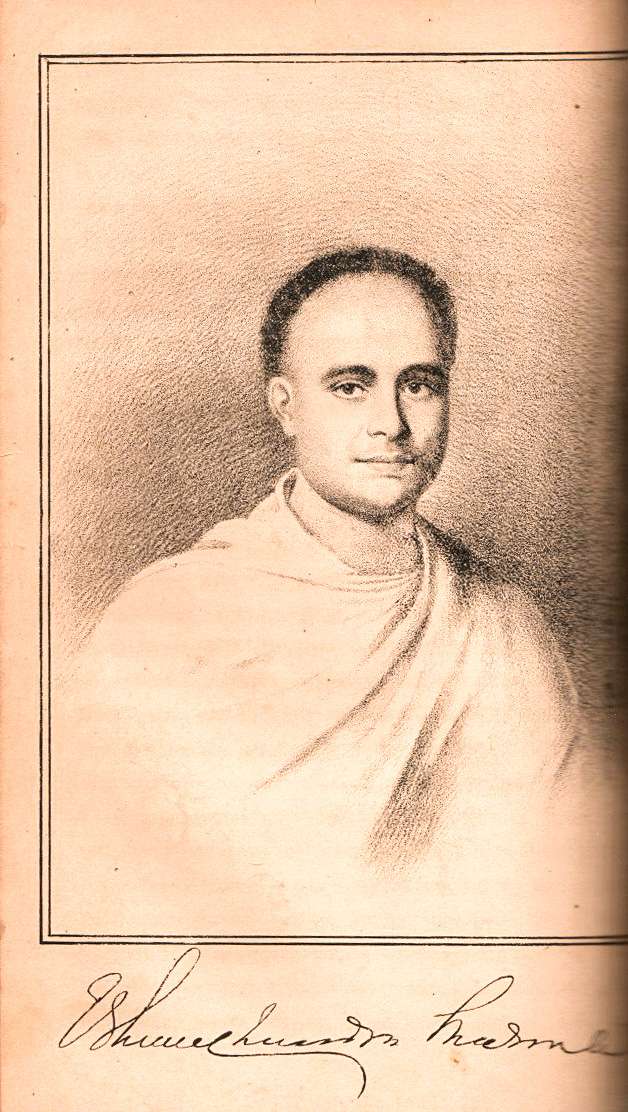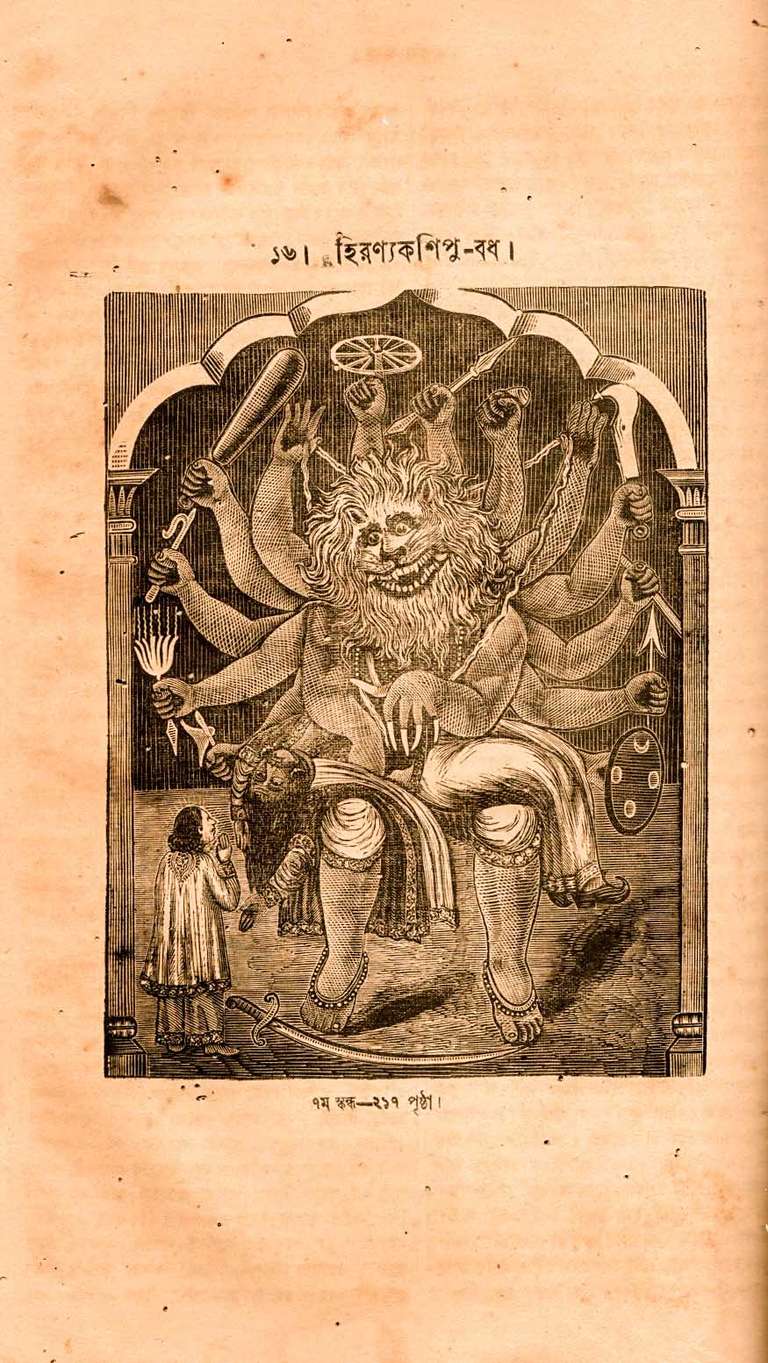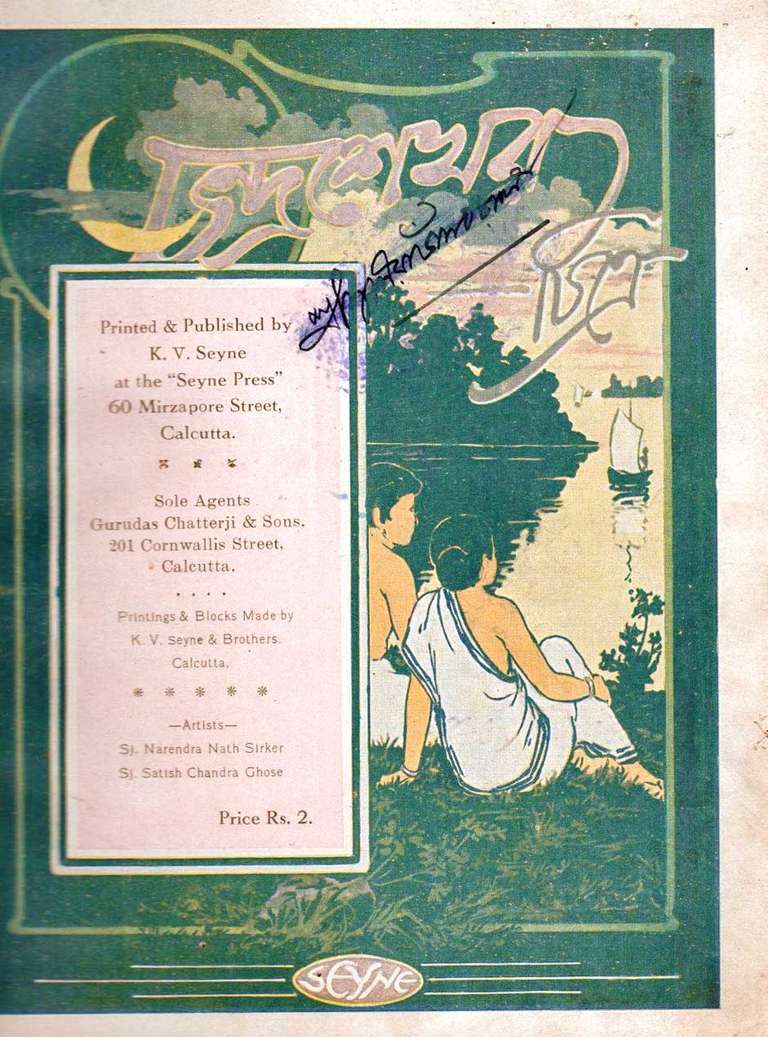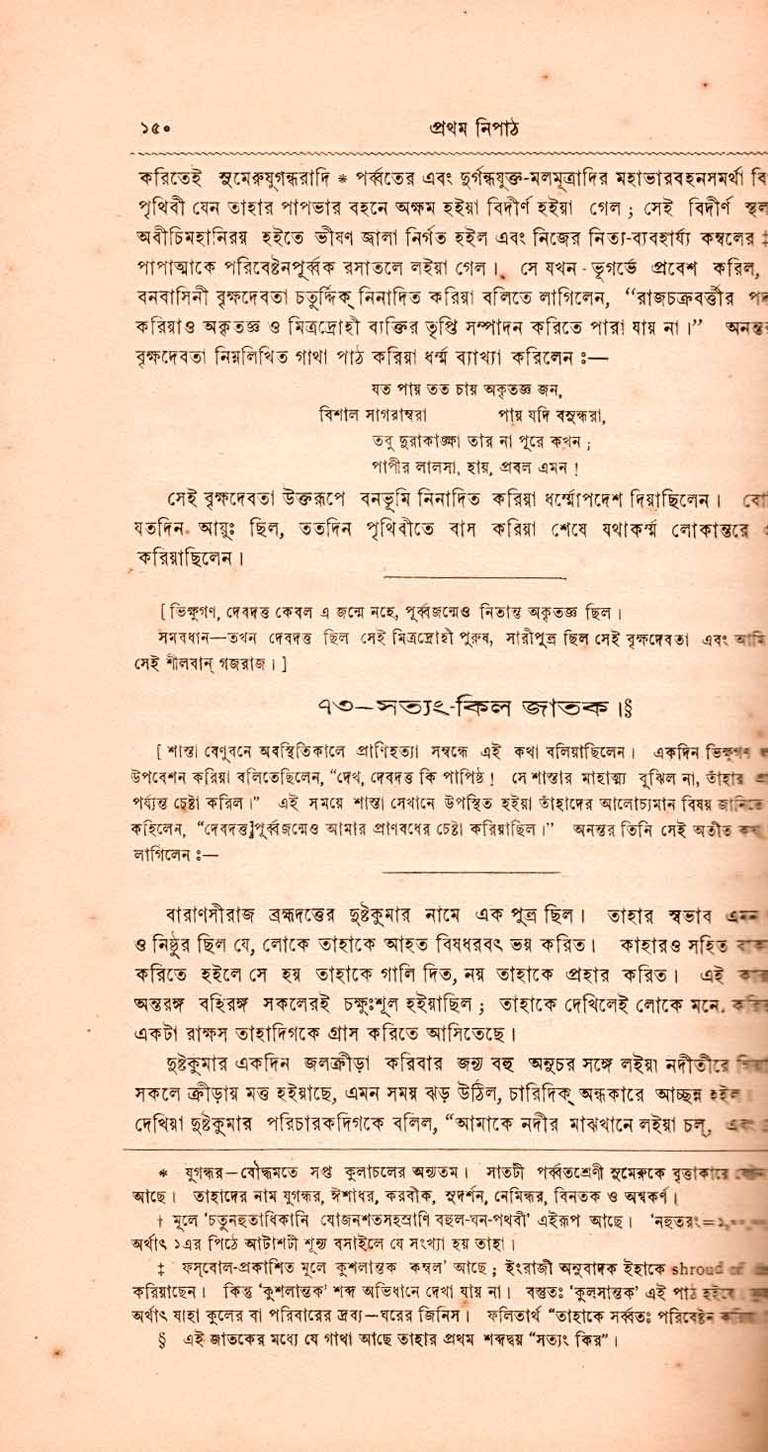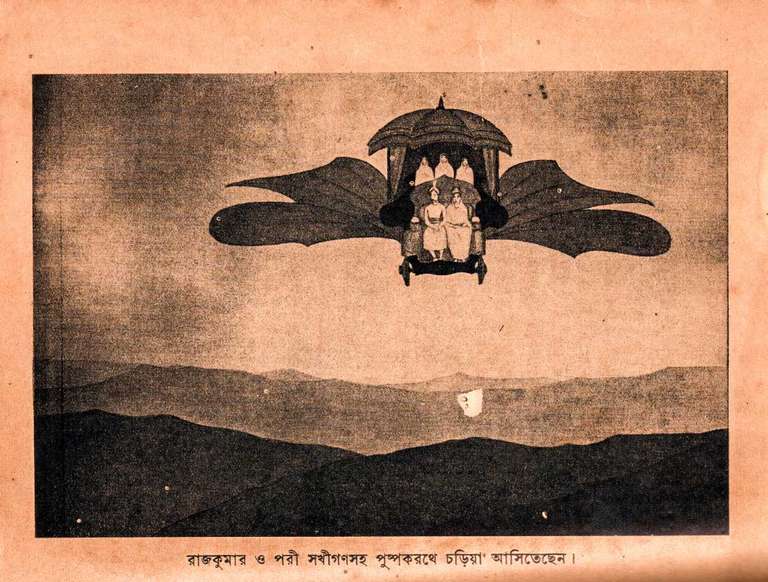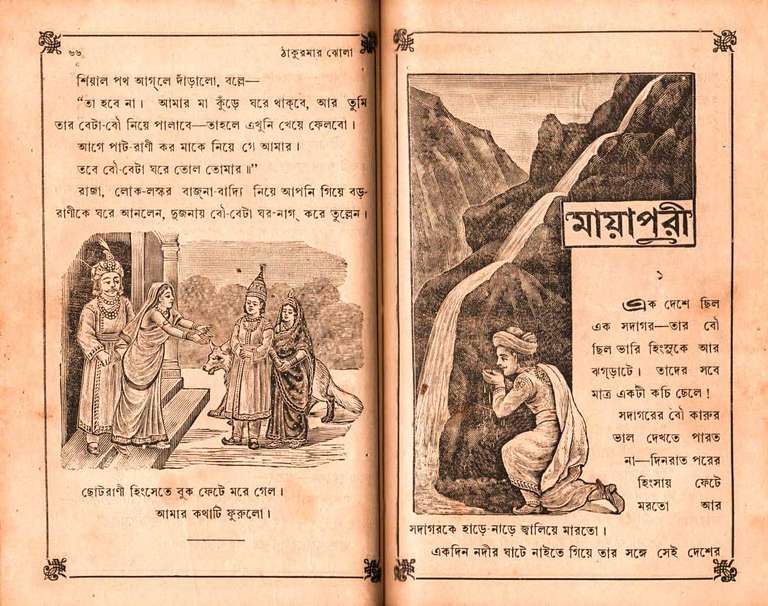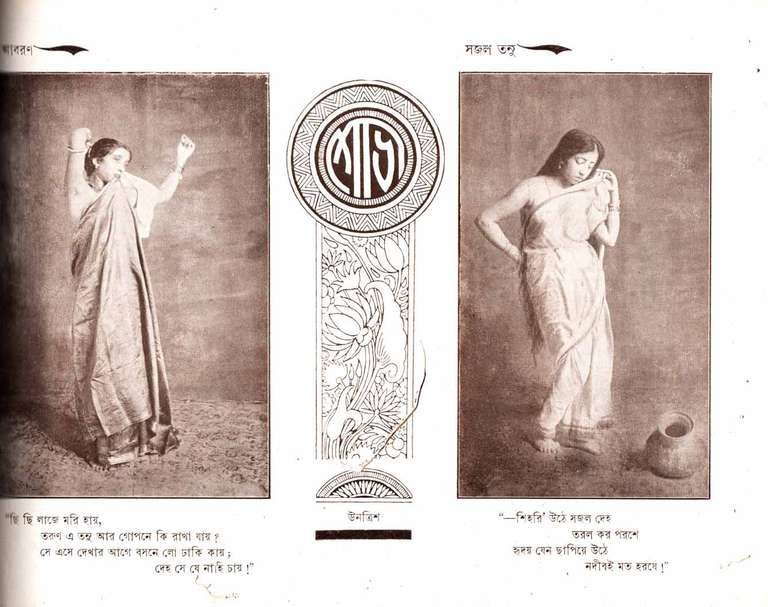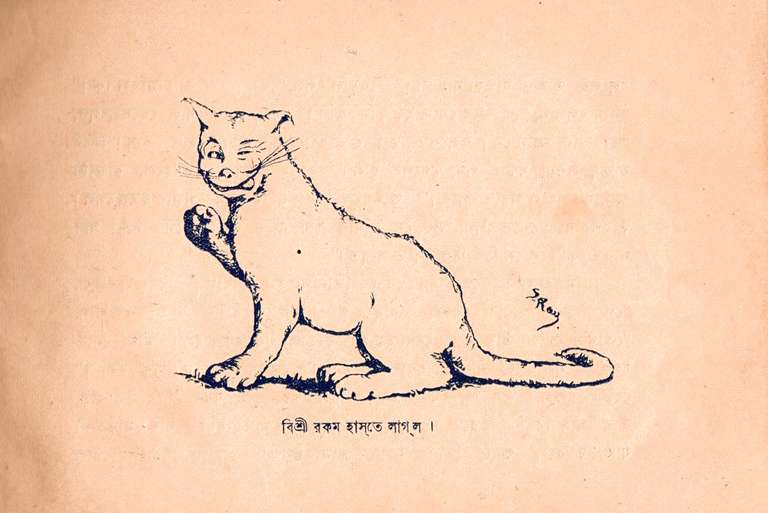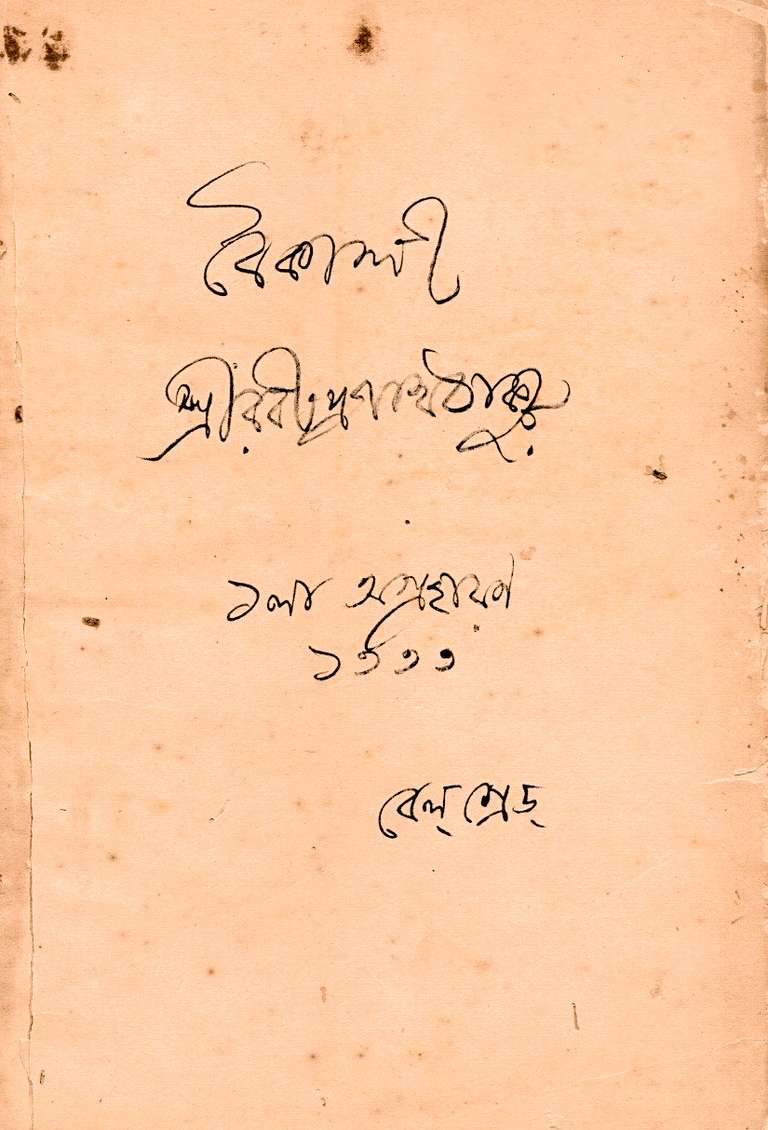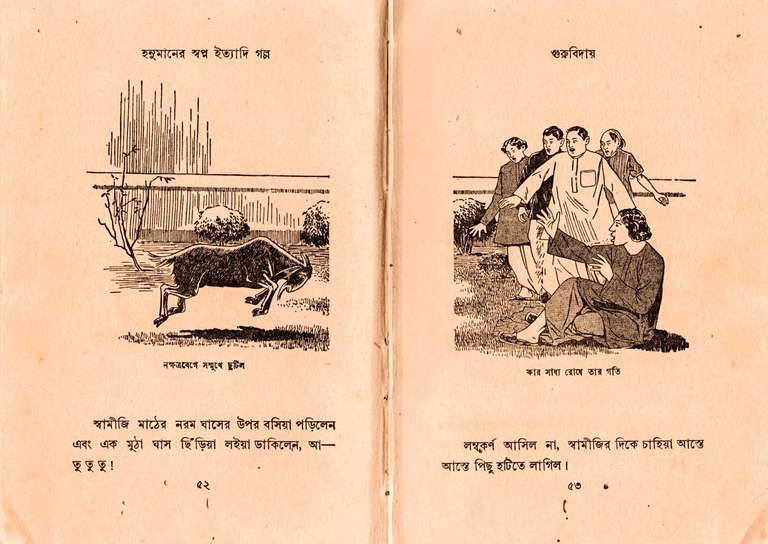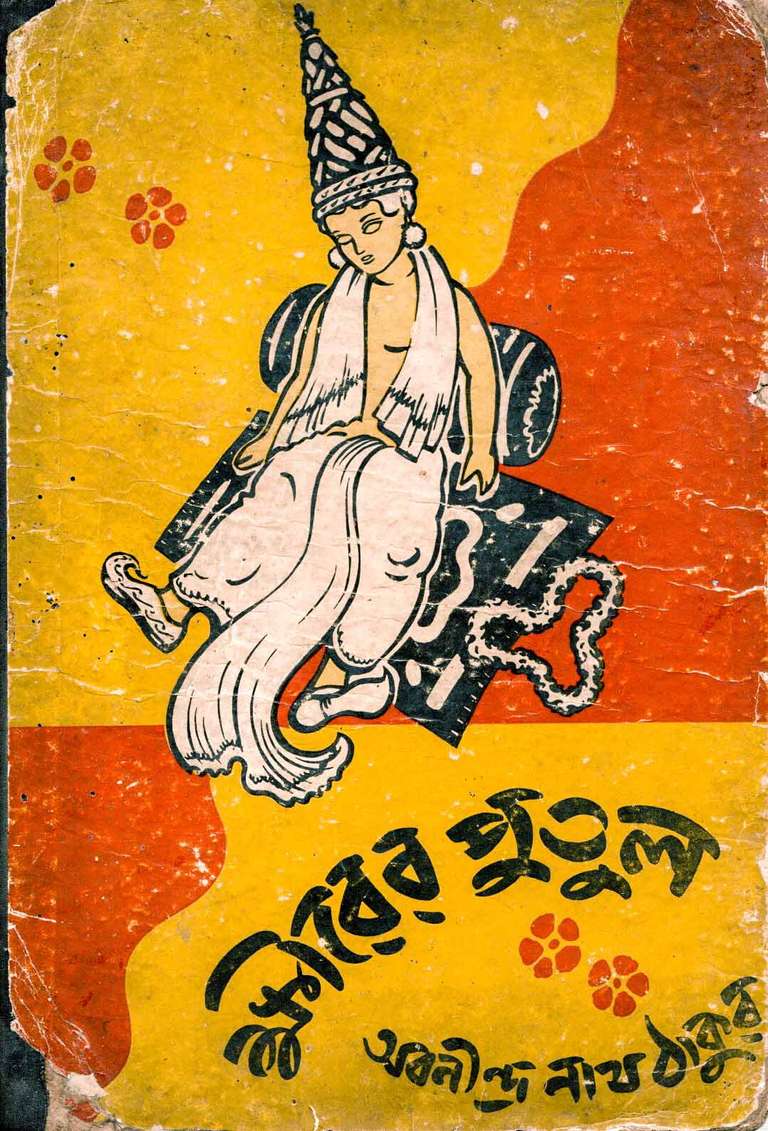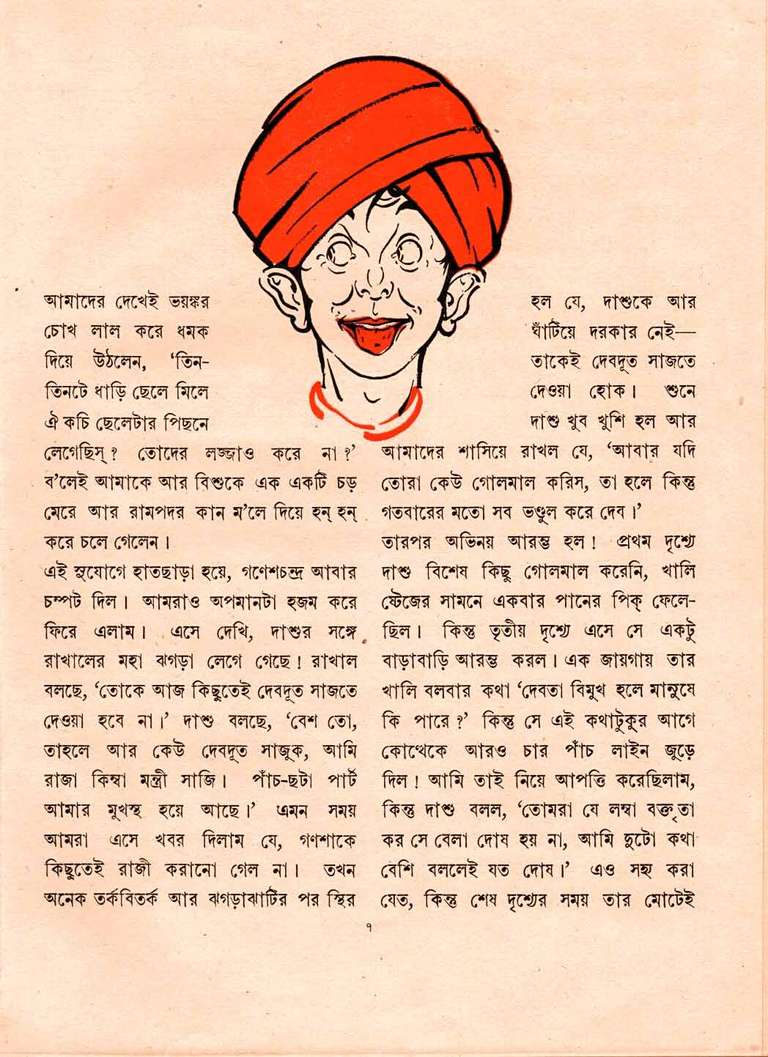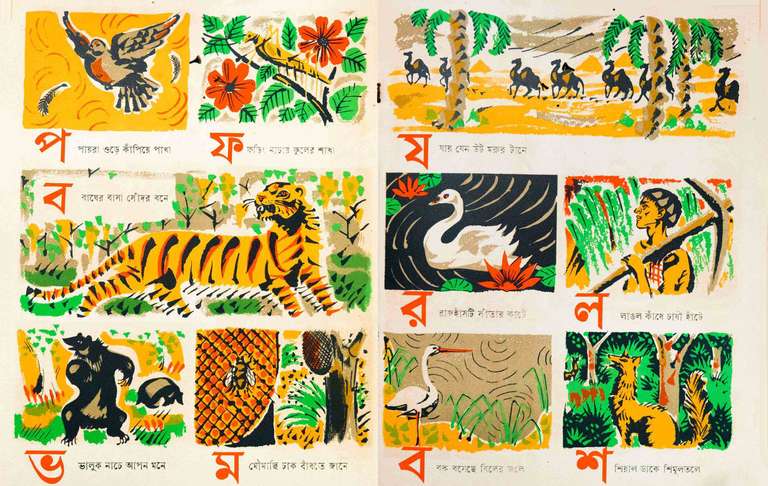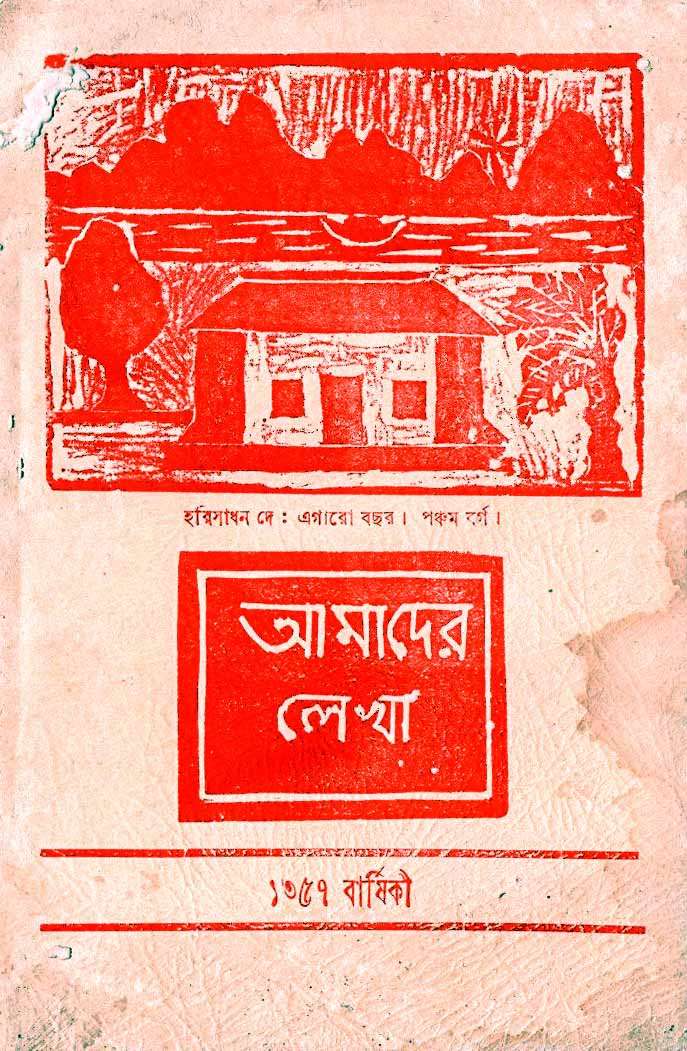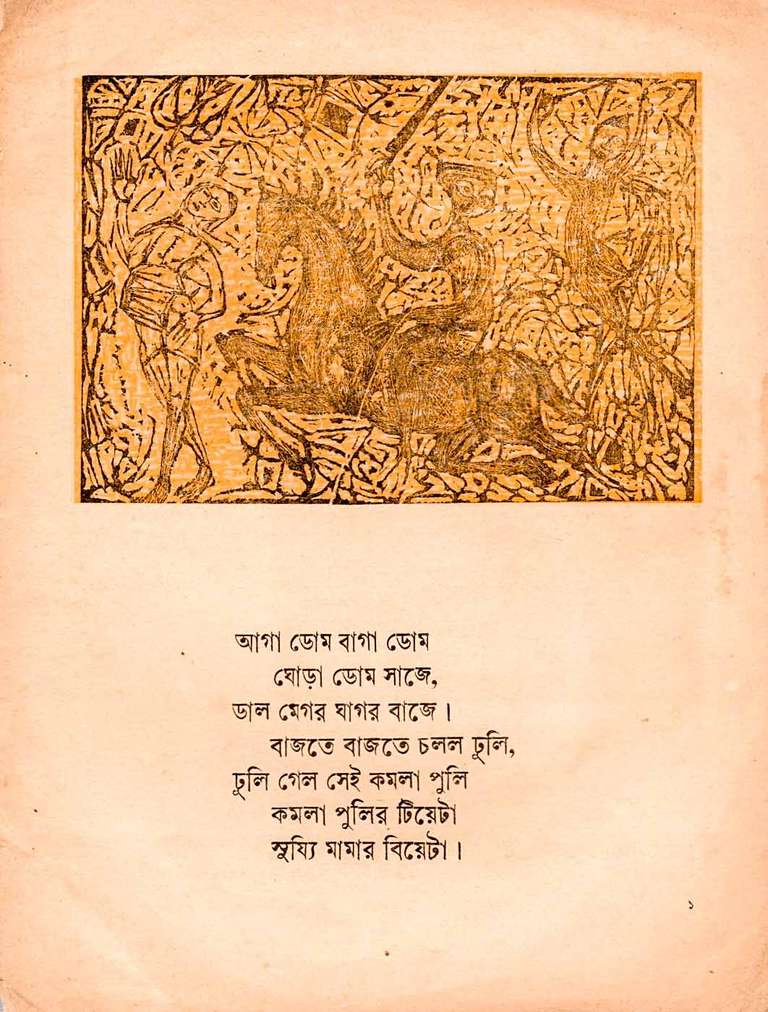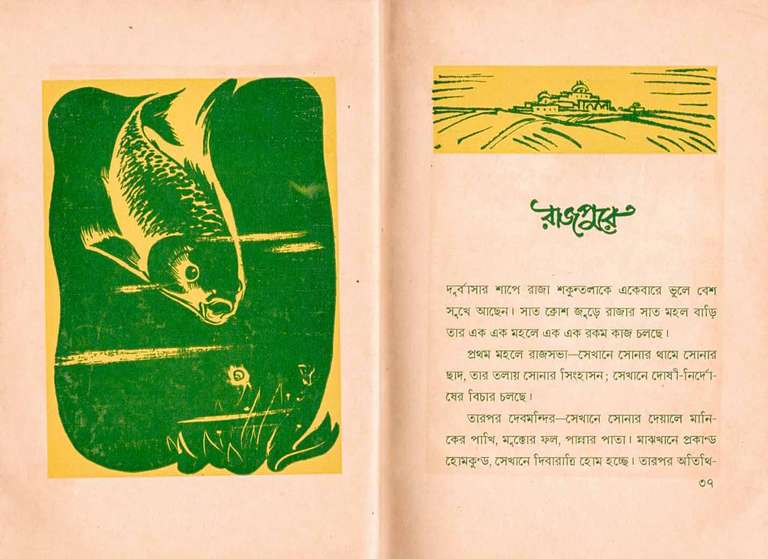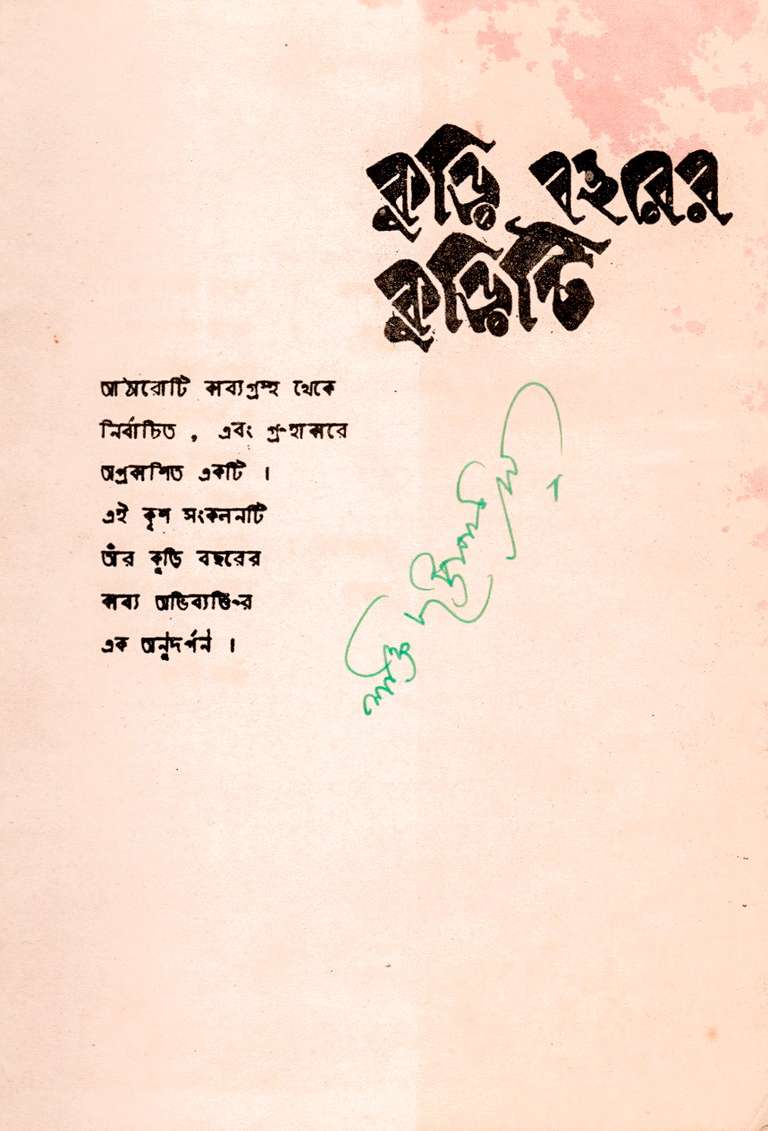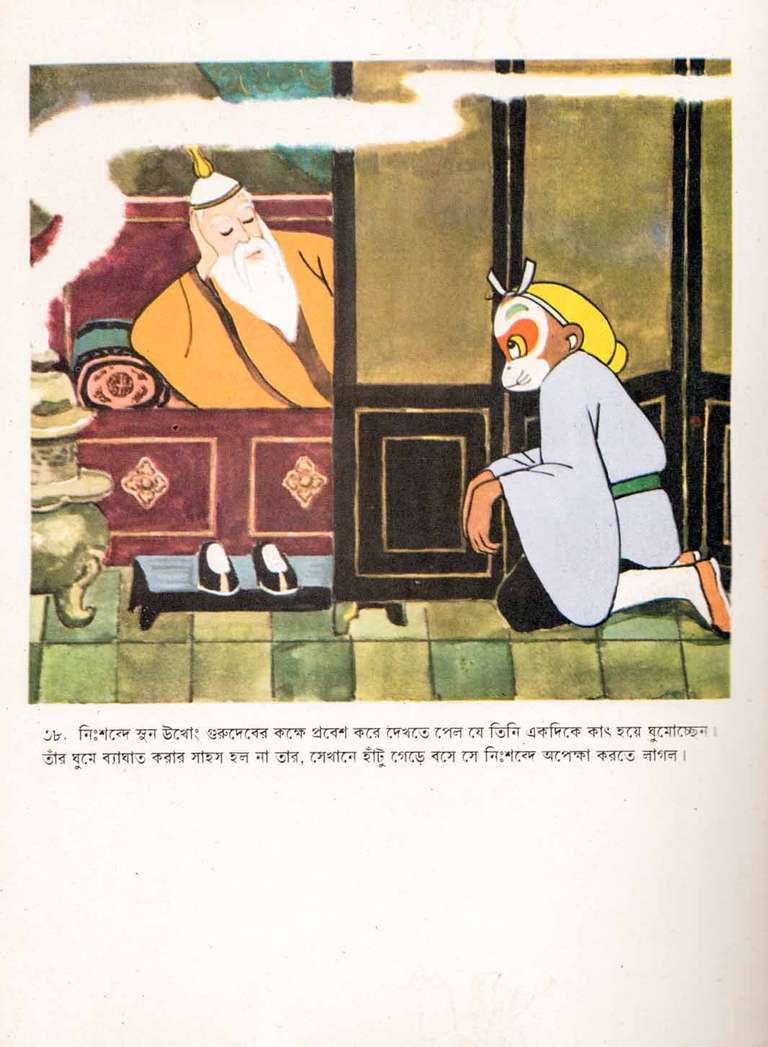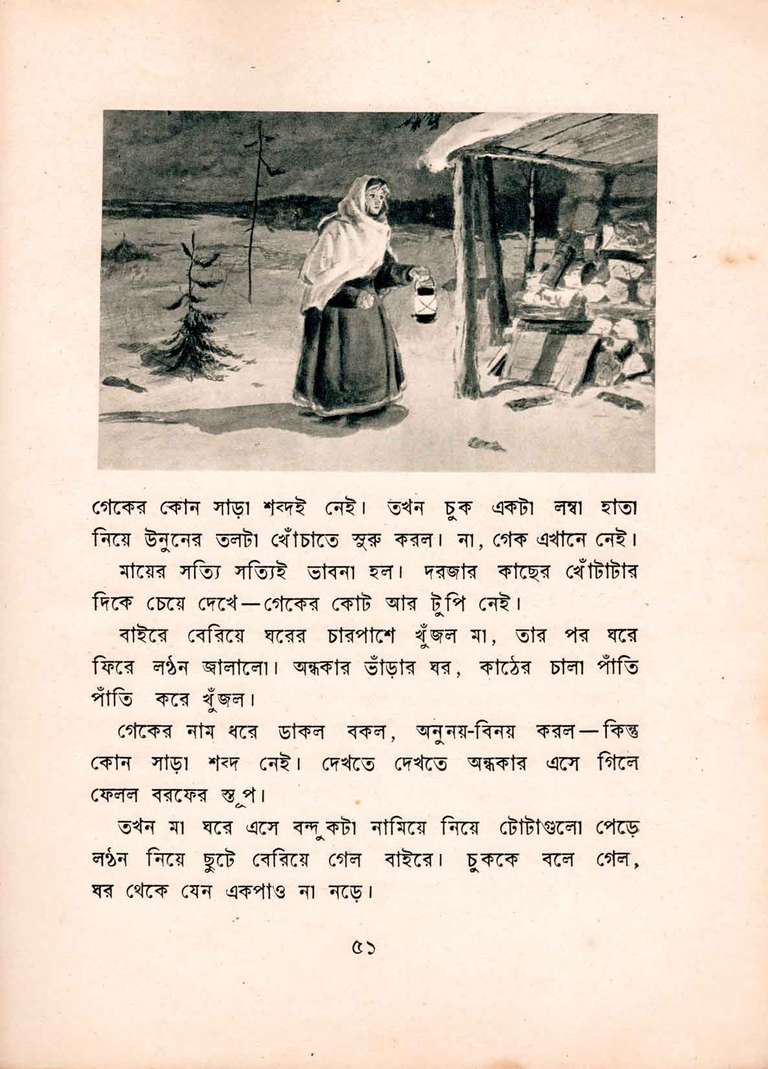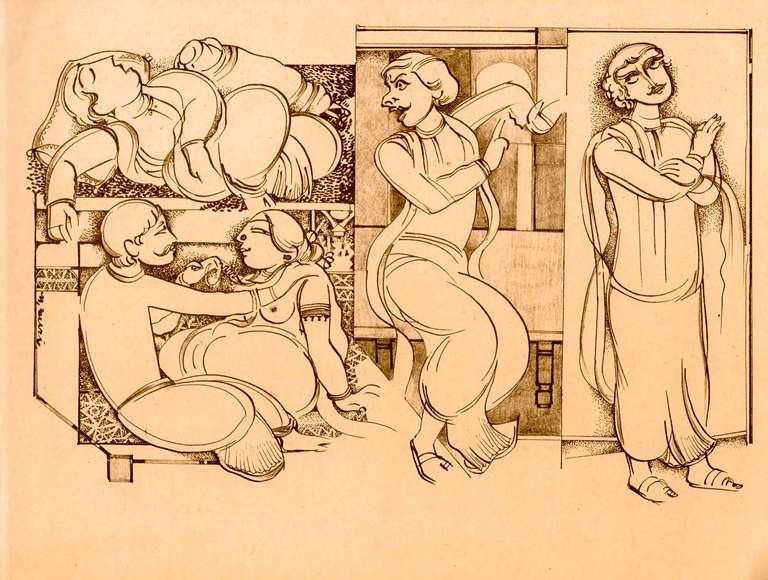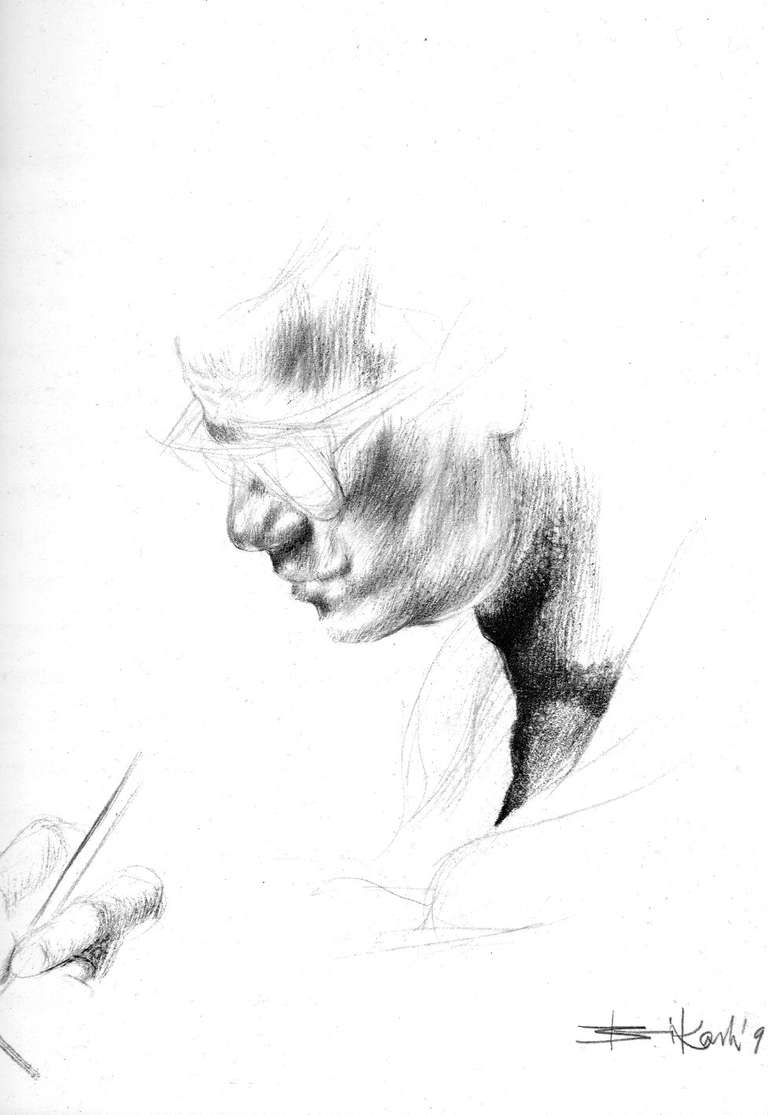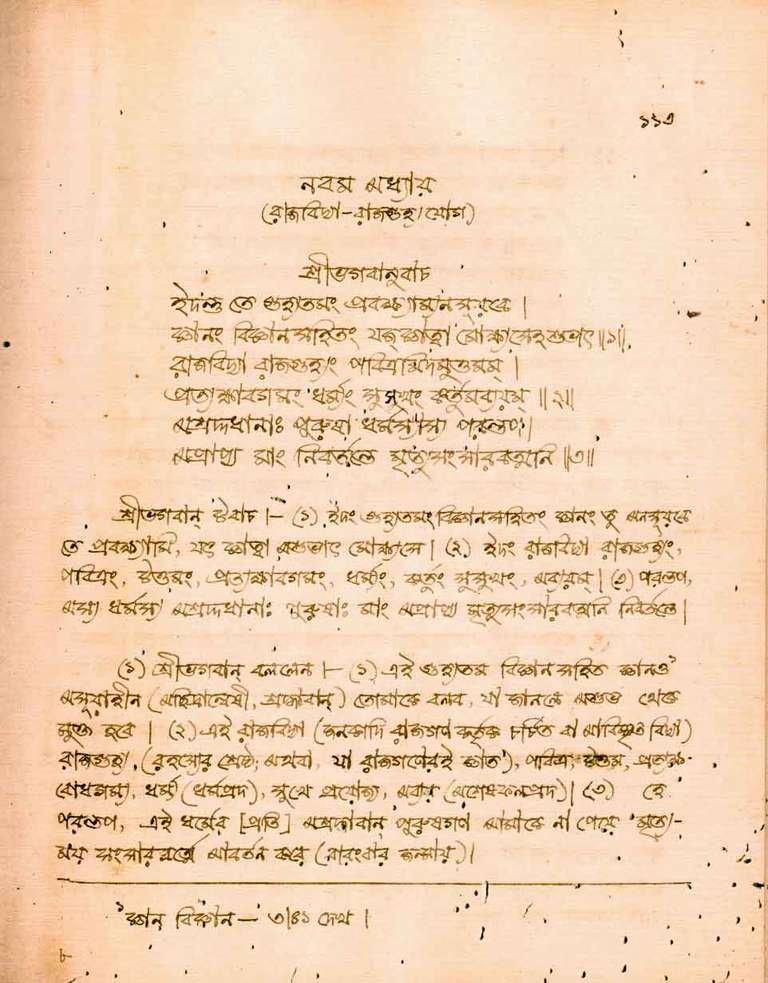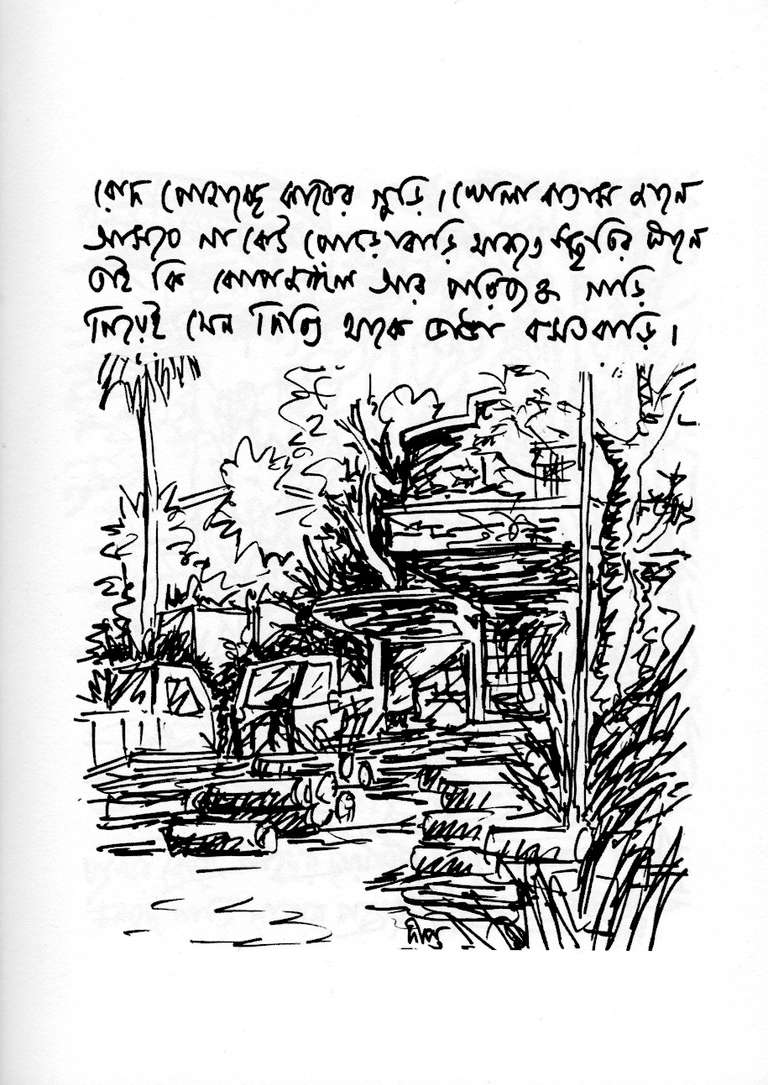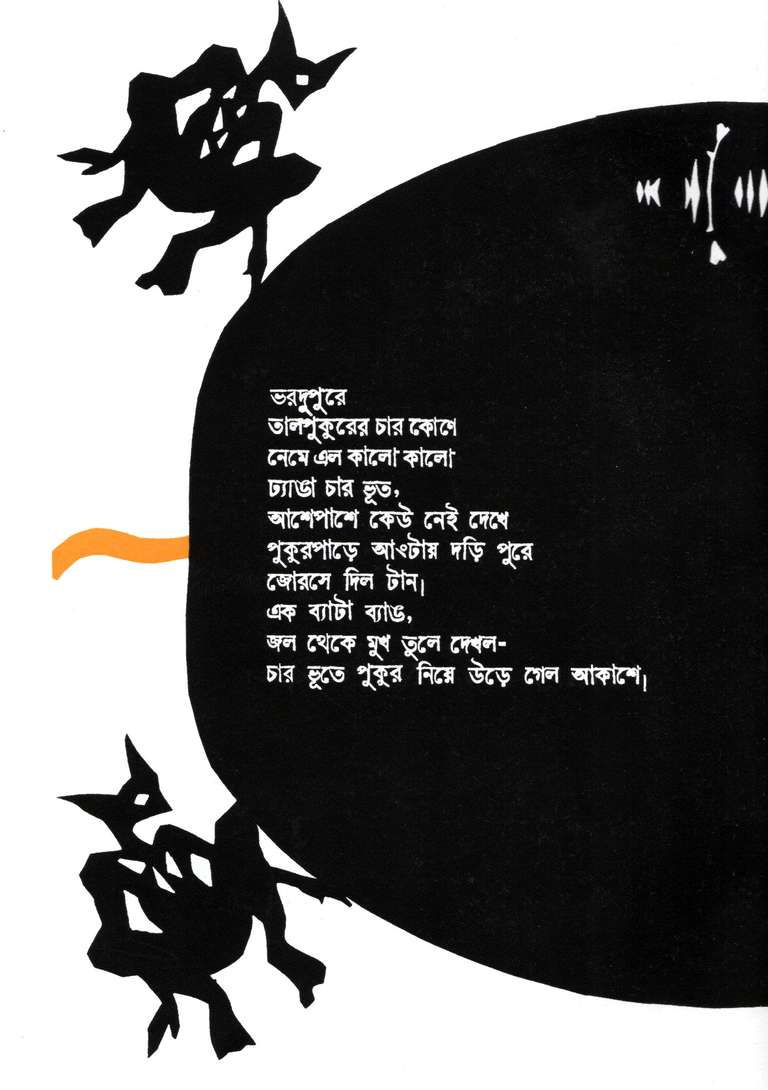T he annals of printed book history in Bengal span an expanse of nearly 250 years, commencing in 1778 with the introduction of letterpress printing and culminating in the contemporary era marked by the prevalence of digital printing technologies. This journey was borne out of the colonial intervention, with the book titled A Grammar of the Bengal Language authored by Nathaniel Brassey Halhed in 1778 serving as the inaugural exemplar to integrate the Bengali script within its pages. With the advent of colonial intervention, the nascent decades of Bengali book production bore witness to a conspicuous Western influence that markedly permeated the realms of aesthetics and craftsmanship. This influence was manifested in various facets of book design and production. However, as the tumultuous currents of nationalist sentiments, as well as the middle-class educated ‘Babu’ class, emerged, a subtle, (sometimes self-contradictory) but discernible shift in the approach to book production developed.
Intriguingly, several pioneering institutions and individuals became torchbearers of this transformation, imparting distinctiveness to the printing culture in Bengal. Among these, the Aadi Bramhasamaj Press, Prabasi Press, Visva-Bharati Granthalaya (later Granthanbibhaga), Signet Press and so on embodied unique facets of this evolving printing culture. Their varied approaches and contributions exemplify the dynamic relationship between book production and the socio-cultural milieu, exploring the minute interplay of aesthetics and linguistic identity in the evolving landscape of Bengali print culture.
Mudranbinyas , the exhibition, is intricately dedicated to the meticulous unravelling of the historical odyssey that defines the evolution of Bengali book printing. This journey, marked by its resilience in the face of rapidly changing political, social, and technological landscapes, has exhibited both mainstream and clandestine trajectories. In the pursuit of curation, we have undertaken the task of dividing this narrative into distinct time frames. It is vital to acknowledge that while our chronology delineates the formative transformations, the examples presented within it do not adhere to a linear progression. Instead, they interweave and overlap across various time frames.
– Sarnali Dutta
Chart of Bengali Printing techniques Name: A Grammar of the Bengal Language (facsimile). Author: Nathaniel Brassey Halhed. Medium: Early Letterpress (Panchanan Karmakar type). Special attributes: Earliest known book with Bengali type, Reprint by Ananda Publishers Pvt. Ltd. Edition: Reprint/Second. Year: 1778. Name: Virgil’s Aeneid (facsimile). Author: H. Sargent. Medium: Early Letterpress (Panchanan Karmakar type). Publication: Serampore Mission Press. Special attributes: Reprint by Jadavpur University Press. Edition: Reprint/Second. Year: 1810. Name: Bharatbarshiyetihas Sar Sangraha. Author: Bydeanath Banerjia. Medium: Early Letterpress. Publication: Sumachar Chundrika Press. Special attributes: Developing old type. Edition: First. Year: 1848. Name: Ramayana. Author: Krittibash Pundit. Medium: Wood engraving and Letterpress. Publication: Sungbad Poorno-Chundrodoy Press. Special attributes: Old type, illustrated. Edition: First. Year: 1852. Name: Sitar Bonobash. Author: Eshwar Chandra Vidyasagar. Medium: Letterpress. Publication: Sanskrit Press. Edition: Second. Year: 1860. Name: Sokriddhatu Path. Author: Goloknath Bhattacharjee. Medium: Letterpress (Old type). Publication: Serampore Tamohar Machine. Special attributes: Children’s primer. Edition: First. Year: 1860. Name: Tattwabodhini Patrika. Author: Dwijendranath Tagore (ed.). Medium: Semi-developed Letterpress. Publication: Kolikata Bramho Samaj. Edition: First. Year: 1867. Name: Nuton Punjika. Medium: early Electrotype and Letterpress. Publication: Kabita Ratnakar Machine. Special attributes: Illustrated. Edition: First. Year: 1874. Name: Geetgovindam. Author: Joydeb. Medium: Electrotype and Letterpress. Publication: Chitpore Kamalkanta Machine. Edition: First Year: 1891 Name: Vidyasagar. Author: Chandicharan Bandyopadhyay. Medium: Lithography and Letterpress. Publication: Metcalfe Press. Special attributes: Illustrated by Annadaprasad Bagchi. Edition: First. Year: 1895. Name: Sreematbhagavat. Author: Panchanan Tarkaratna (ed.). Medium: Wood engraving and Letterpress. Publication: Bangabashi Steam-machine Press. Edition: First. Year: 1900. Name: Chandrashekhar Chitre. Author: Bankim Chandra Chatterjee. Medium: Early colour Halftone and Letterpress. Publication: K.V. Syne and Brothers. Special attributes: Illustrated by Narendranath Sirker, Satish Chandra Ghose. Edition: First. Year: 1914. Name: Jataka (vol. 1). Author: Eshan Chandra Ghosh. Medium: Letterpress (Standerdised pica type). Publication: Nababibhakar Press. Special attributes: Different points of type in single page layout. Edition: First. Year: 1916. Name: Hindusthani Upokotha. Author: Santa Debi, Sita Debi. Medium: Monochrome Halftone and Letterpress. Publication: Prabashi Karyalaya. Special attributes: Illustrated by Upendrakishore Ray Chowdhury. Edition: Third. Year: 1920. Name: Thakurmar Jhola. Author: Satyacharan Chakravorty. Medium: Electrotype and Letterpress. Publication: Bhattacharjee and Sons. Special attributes: strong influence of ‘Thakurmar Jhuli’ by Dakshinaranjan Mitra Majumder in production aesthetics and materiality. Edition: Second. Year: 1920. Name: Shobha. Author: Bhabanicharan Laha, Rabindranath Tagore. Medium: Monochrome Halftone and Letterpress. Publication: Bashumati Sahitya Mandir. Special attributes: Colour Monochrome plate of Studio Photographs. Edition: First. Year: 1926. Name: HaJaBaRaLa. Author: Sukumar Ray. Medium: Line block and Letterpress. Publication: U. Ray and Sons. Edition: Second. Year: 1931. Name: Boikali. Author: Rabindranath Tagore. Medium: Plate Lithography. Publication: Visva Bharati Granthalaya. Special attributes: Published from direct handwriting. Edition: First. Year: 1931. Name: Hanumaner Swapno ityadi Galpo. Author: Rajshekhar Bose. Medium: Linotype and Line block. Publication: M.C. Sarkar and Sons. Special attributes: Illustrated by Jatindrakumar Sen, First book to be printed in Linotype. Edition: First. Year: 1937 Name: Kheerer Putul. Author: Abanindranath Tagore. Medium: Colour Line Block and Letterpress. Publication: Signet Press. Special attributes: Cover Design and Illustrations by Satyajit Ray. Edition: Second. Year: 1945. Name: Pagla Dashu. Author: Sukumar Ray. Medium: Colour Line Block and Letterpress. Publication: Signet Press. Special attributes: Illustrated by Satyajit Ray. Edition: First. Year: 1946. Name: Hate Khori. Author: Bimal Chandra Ghosh. Medium: Offset Lithography. Publication: Dipankar Bhavan. Special attributes: Primer for Children, Illustrated by Satyajit Ray. Edition: First. Year: 1948. Name: Aamader Lekha. Medium: Linocut and Letterpress. Publication: Patha Bhavana, Visva Bharati. Special attributes: School magazine. Edition: First. Year: 1950. Name: Pankouri. Author: Kamal Kumar Majumdar. Medium: Woodcut, Block and Letterpress. Publication: Subarnarekha. Special attributes: Printing in mixed medium. Edition: Second. Year: 1966. Name: Sakuntala. Author: Abanindranath Tagore. Medium: Colour Line Block and Letterpress. Publication: Signet Press. Special attributes: Cover Design by Satyajit Ray, Illustrations by Makhan Duttagupta. Edition: Eighth. Year: 1966. Name: Kuri Bochorer Kuriti. Author: Shakti Chattopadhyay. Medium: Xerox. Publication: Maya Sengupta (privately printed). Special attributes: Signed Limited edition for private circulation. Edition: First. Year: 1979. Name: Sun Wukong-er Jonmokotha. Author: Liu Aihao. Medium: Offset. Publication: Bideshi Bhasha Prakashanaloy (China). Special attributes: Bengali book printed in China. Edition: First. Year: 1984. Name: Chuk aar Gek. Author: Arkadi Gaidar. Medium: Offset. Publication: Bideshi Bhasha Prakashanaloy (Russia). Special attributes: Bengali book printed in Russia. Edition: First. Year: 1950’s (exact date unknown). Name: Chobite Sri Sri Ramkrishna Kathamrita (Vol. 1). Author: Ramananda Bandyopadhyay. Medium: Offset. Publication: Self Published. Special attributes: Private printing for private circulation. Edition: First. Year: 1992. Name: Cholar Pothe. Author: Santosh Kumar Ghosh. Medium: Offset. Publication: Ananda Publishers Pvt. Ltd. Special attributes: Illustrated by Bikash Bhattacharya. Edition: First.Year: 1996. Name: Minabazaar. Author: Prabir Sen. Medium: Colour Woodcut and Letterpress. Publication: Prakriti. Special attributes: Illustrated by Krishnendu Chaki, Limited Edition of 100 copies. Edition: First. Year: 2003. Name: Srimadbhagavatgeeta. Author: Rajshekhar Bose. Medium: Digital Print. Publication: The Colors of Art. Special attributes: Facsimile of a manuscript. Edition: First. Year: 2017. Name: Khata Kolom. Author: Dipto Dasgupta. Medium: Print on Demand. Publication: Rhito Prakashan. Special attributes: Hand written. Edition: First. Year: 2019. Name: Dosh Asharey. Author: Soumyadip Ray. Medium: Serigraphy. Publication: Privately Printed. Special attributes: Illustrated by Aranya Sengupta, Limited Edition of 30 copies. Edition: First. Year: 2020.
